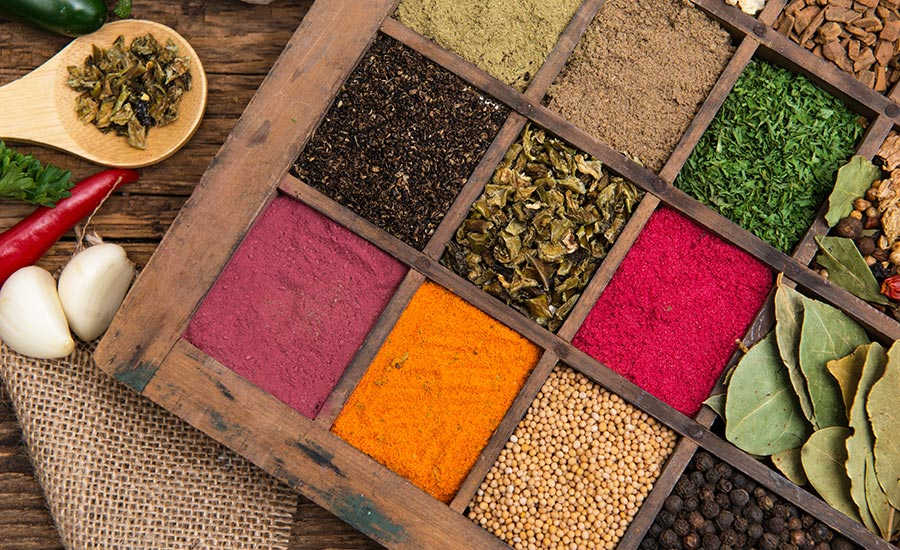The past 30 years have seen the market demand for food colorants changing in substantial ways, particularly regarding the choice between synthetic and natural colorants. Not so long ago, synthetic colorants were preferred because of several benefits: They are easy to use, deliver bright colors in a variety of food matrices, and perform in consistent and predictable ways. Moreover, they are inexpensive to use.
Synthetics also are available in concentrated form and dissolve readily in water (dyes) or disperse well in fat-based systems (lakes). They are quite stable in most applications and are generally resistant to the effects of heat, light, and pH. Of course, there are exceptions, but these statements are generally true where synthetic colorants are concerned, and this explains their decades-long popularity with food scientists and manufacturers.
Another factor in the use and acceptance of synthetics was simply that consumers did not seriously question the inclusion of such colorants in the products they chose to purchase. There was a general assumption that the food supply was safe and that synthetic ingredients presented no harm.
Today, however, heightened consumer awareness of and concern over the contents of food, along with preference changes when it comes to synthetic ingredients including colorants, are inescapable. In some cases, these attitudes might be founded on a lack of understanding of the types of additives and ingredients permitted for, or used by manufacturers in foods and beverages.
Natural Challenges
This shift in consumer perception of synthetic food colorants, and the accompanying demand for colorants derived from natural sources, have created both problems and opportunities for food and beverage manufacturers. Natural colorants are more expensive on a cost-in-use basis than synthetic colorants. While colorants in general are used at very low levels in foods and beverages, the cost of natural colorants is still substantially higher — as much as 5 to 50 times higher, depending on the colorant and the application.
The color palette available from synthetic colorants can be difficult to match using naturally derived colorants. For example, until seven years ago there was no good natural blue colorant. New colorants that fill this performance gap have been approved and are finding broader use.
Natural colorants also may behave in predictable ways, but generally they are more complex to use correctly than synthetic colorants. Many popular natural colorants are soluble only in water, while others are soluble only in oil. There are some formulations of water-soluble natural colorants that can be used in fat-based formulations, but they tend to be expensive and the colors tend to be muted and pastel rather that bright and vivid.
It is possible to emulsify fat-soluble natural colorants into water-based food systems, but successful application is highly dependent on the formulation and the matrix, especially in regard to pH. Some natural colorants, most notably the general class called anthocyanins, are highly sensitive to pH. They tend to be most stable in lower pH conditions, where they provide bright red berry-like colors. As the pH becomes more alkaline, they turn violet or blue and tend to degrade quickly in beverage applications.
Shelf life of the color in application can also be a concern with natural food colorants in comparison to their synthetic counterparts. Stability under exposure to heat and light vary with the colorant identity. Red beet gives an appealing red color that is quite pH stable. Unfortunately, it degrades under heat rapidly in water-based food systems. On the other hand, turmeric oleoresin is quite heat stable, but degrades quickly with exposure to direct light.
Making it Last
Because of the challenges faced by the colorant industry regarding natural forms of food and beverage coloring agents, technologists have found it necessary to respond with innovations that permit the successful use of natural food colorants in increasingly challenging applications.
These innovations have been, in some cases, driven by the introduction and FDA acceptance of new food colorants. While spirulina extract is approved as a natural blue colorant for use in foods and beverages there are limitations on its use. Still, it represents a substantial improvement in the natural color palette.
Another natural blue colorant, made by combining the juice of the tropical huito fruit with watermelon juice, has been introduced as a self-affirmed GRAS ingredient and is experiencing increased use. Other innovations rely on applications of processing and formulation technology that confer specific benefits where stability, solubility, or performance are concerned.
Food scientists have actively searched for ways to stabilize natural colorants to close the stability gap between naturals and synthetics. It has long been known that the tocopherol form of vitamin E and natural extracts from sources such as rosemary can act as “sacrificial” antioxidants to protect carotenoid colorants such as annatto, paprika, beta-carotene, and others from oxidative degradation. This lengthens the viable shelf life of these colorants in application.
These natural antioxidants can be applied effectively to specific formulations and applications, as it is necessary to combine the antioxidant intimately with the carotenoid colorant to achieve meaningful stabilization. This can be simple in the case of fat-based formulations (in which antioxidant and color are readily soluble), but it is more challenging when the colorant is to be incorporated into a water-based (beverage) matrix.
More recent additions to the natural colorant palette (anthocyanins from red radish, purple sweet potato, red cabbage, and black carrot) have been found to naturally contain their own attached co-pigment (intramolecular co-pigmentation). This factor greatly enhances their stability and permits use across a greater pH range.
Other naturally occurring substances, including the aforementioned extract of rosemary, can interact with anthocyanins to form co-pigmentation complexes. These have been shown to protect the anthocyanins from degradative processes. When blended in the appropriate amounts with anthocyanin colorants such as grape skin extract, the intermolecular co-pigmentation interactions provide enhanced stability.
Lake Side
Food manufacturers have had access to two functional types of synthetic (FD&C) colorants. These are known as dyes, the water-soluble versions of synthetic colorants, and lakes, an oil-dispersible preparation made from the corresponding dyes. Dyes dissolve easily in water. They function by absorbing photons of light with particular energies and reemitting the energy as visible light.
Lakes, on the other hand, are not soluble except at extremes of pH, and exist as dispersions of discrete, highly colored particles. These function by reflecting light at specific wavelengths characteristic of the dye that is embedded in the particles.
Lakes are used in many applications where dyes cannot be used. They are readily dispersible in oil-based systems where dyes do not function. Their unique composition makes them useful in applications like colored icings for cake decorations. Although water is limited in frosting and icing applications, there is typically sufficient water to dissolve dyes.
While they give bright, vivid colors, they are also known to run or bleed from colored icing into the white base icing. This is because the dyes will move with the water that is present in the icing or frosting, and as the water migrates, so does the dye. As the water evaporates, the dyes are left behind, creating “patchwork” color effects.
Lakes are made by embedding dye molecules into an insoluble substrate that holds the dye in place. This means that lakes can be used in frosting and icing applications where they limit or eliminate bleeding. They are commonly used in confections such as coated candies, where it is preferred that the color stay on the coating rather than deposit in the hand of the consumer. Lakes are also used in topical seasonings to provide characteristic appearance to spice and seasoning blends.
One to Beet
Red beet juice can be expressed directly from mature, edible beets and processed into a concentrate that delivers an appealing bright red color. It can be a suitable replacement for FD&C Red #40, but its use has been limited previously. A major barrier to more extensive use of red beet juice colorant has been instability in alkaline conditions and under high temperatures. The predominant degradation pathway for the red beet color involves water, and that degradation is accelerated by the presence of heat and alkalinity.
In the past, red beet had not been successfully used in typical baked products like cupcakes because the combination of water content and high temperatures during baking caused rapid and complete degradation. It has since been discovered that the alkaline conditions caused by standard leavening agents were probably as much a cause as the heat and water content.
By using an acidulent to balance the pH of the batter to below 6.5, the ability of red beet colorant to survive baking conditions is greatly improved. Of course, this can affect the leavening system, so a careful balance must be struck.
“Red velvet” baked goods are popular and, historically, they were given their characteristic red hue with relatively high application rates of FD&C Red #40. There has been substantial demand for a natural replacement, but attempts to use red beet juice generally met with failure. The leavening system played a part by elevating the pH of the batter, but it turns out that alkalized cocoa powder, which is used at high levels in the application, also prevented the successful use of red beet colorant.
By lowering the pH of the batter to below 6.5, it is possible to achieve a stable color in red velvet cupcakes using red beet colorant. Again, caution must be taken to balance the needs of the leavening system against the pH conditions. Leavening is not as effective under even mildly acidic conditions.
Red beet can also be used to color hard-boiled candies, even though high temperatures are involved in the manufacturing process. This seems to be because the presence of water is greatly reduced in the final stages of manufacturing. That condition apparently short-circuits the thermal degradation pathway.
A Mellower Yellow
As noted above, the coloring principle (curcumin) in turmeric is an exceptionally bright and appealing yellow color. It is also extremely sensitive to light, fading quickly to colorlessness under direct exposure. For this reason, turmeric oleoresin colorant typically has been used in applications where light exposure can be closely controlled or eliminated.
In addition to being light sensitive, turmeric oleoresin is notoriously insoluble in both fats and water. Historically, preferred presentations of turmeric oleoresin included a low-color content solution in vegetable oil (~0.2 % wt/wt), a dispersion of milled curcumin in propylene glycol, or a clear, dark solution in polysorbate 80.
As consumer demand for the replacement of synthetic ingredients has increased, it has become necessary to find alternative formulations. It is now possible to obtain water-dispersible curcumin liquids and powders that are emulsified with naturally derived ingredients such as gelatin or gum Arabic.
Efforts to overcome light sensitivity also have met with some success. It has been shown that micro-dispersions of curcumin exhibit better stability to light than curcumin that has been dispersed via the use of an emulsifier like polysorbate 80. It is believed that the more effective dispersion technology utilizing polysorbate 80 reduces the curcumin to essentially molecular dispersions of single molecules, making them more directly susceptible to the effects of light.
A microdispersion created by milling curcumin powder to extremely small particle size produces a dispersible curcumin particle that contains many curcumin molecules. Those on the outer surface act as shields, protecting the inner molecules from the effects of light and extending the useful shelf life of the color in application.
Nature's Lake
Until a few years ago, the only version of a natural colorant that was available in lake form was carmine. Carmine is a vivid and extremely stable natural red colorant derived from an insect. The coloring principle (dye) is carminic acid, and the more common commercial form is a lake of carminic acid.
While carmine is a very useful natural colorant, its popularity has declined rapidly in recent years due to consumer awareness of its source and resultant disinclination to accept products containing it. Still, it remains in use in select applications where its stability and attractive appearance are not matched by alternatives.
Other than carmine, there had been no version of any natural colorant in a form that functions like a synthetic lake. This is partly due to the chemical process that is used to form lake colorants, which typically involves the use of inorganic salts. However, a few years ago, a process was developed that substantially mimics the lake process without using inorganic salts. The process is relatively complex, but the result is a useful form of natural colorant that fills an application void.
The natural colorant of choice is mixed with water, a plant protein, and other food-grade ingredients to form a colored dough. The dough is extruded under pressure and high heat. The heating and extrusion processes are controlled so that the protein goes through a glass transition to form a more brittle, less opaque matrix. The result is a puffed, brittle, colored piece. This product is broken up, crushed, and milled to produce a fine powder. Particle sizes are generally in the 1-5µ range, as is the case with synthetic lakes.
The powders thus produced will readily disperse in oil-based preparations. The colors tend to be more pastel and less vivid than those provided by synthetic lakes, but this type of colorant extends the useful range of natural colorants beyond where it was only a few years ago.
There are many food ingredients that also provide color to the foods in which they are used. Classic examples are spice products like paprika and turmeric. Juices and extracts expressed from other red and purple plants — such as red cabbage, red radish, berries, and grapeskin — also are being used to greater effect.
All of these are permitted for use in foods and beverages by FDA regulation, as they appear on a list of permitted food colorants. Other natural products that impart color, such as coffee, tea, and cocoa powder, can give useful and desirable colors. However, they are not permitted explicitly for use as colorants. Therefore, if a food ingredient is not on the permitted list of food colorant additives, it is not permitted when used solely for coloring purposes.
In the EU, attempts have been made to codify the use of foods that impart color as “coloring foods.” Since they may be classified as foods rather than as ingredients or additives, food manufacturers avoid the inclusion of E-numbers or unrecognizable “chemical-sounding” names on their labels.
Taking red beet juice as a convenient example, the difference between red beet juice colorant (E162) and red beet juice as a coloring food is mostly just concentration. Extracts or juices from coloring foods may only be concentrated to a certain percentage relative to the concentration in the parent source. Red beet juice colorant may be concentrated to a greater extent. These nuances have little meaning under FDA jurisdiction, as the coloring foods category is not recognized, and any food colorant used in any application must be declared on the label per FDA guidelines.






























